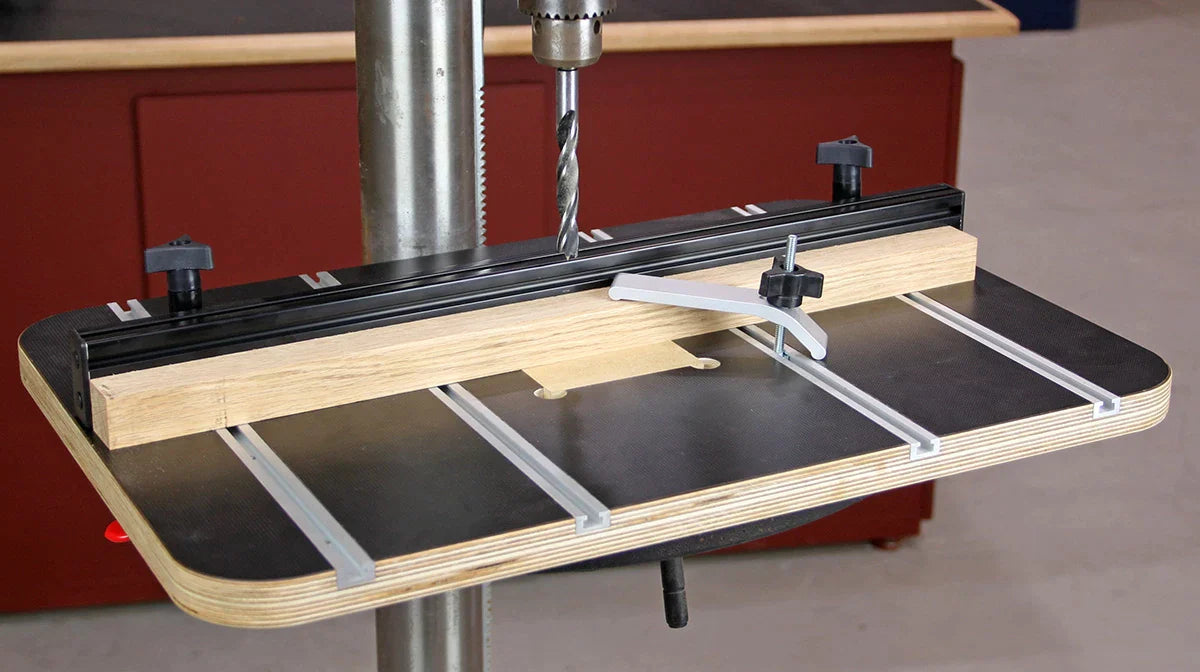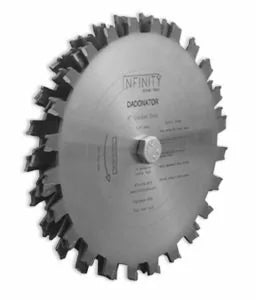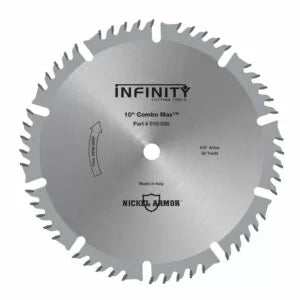
|
Dive Deep on Infinity Tools Saw Blade Technology
Saw Blade University - Part 2
Welcome to part two of our Saw Blade University. In this post we get more into the details regarding the design of our blades and give you some very useful information to help you choose the right saw blade for your application. Do you know what the "Golden Rule" is? If not, keep reading and you'll discover the differences in tooth count, tooth configurations, and why gullets and expansion slots are important to blade performance. Good quality circular saw blade design is as important as using the best raw materials and production techniques and making sure you've got the right saw blade for the job will make a big difference. Read below to learn more about choosing the best saw blades for your shop.
Advanced Blade Design:
Some Talk About Teeth
The number of teeth on a saw blade and their shape is one of the more significant aspects of its design. Tooth count should be based on an intended application and the other parameters of the blade. If all other parameters are equal, more teeth will equate to a cleaner cut but there are several other factors that influence cutting performance. For every design choice there are pros and cons, and more teeth is not always better. More teeth also means more friction and heat, more resistance to the saw, slower feed rates, and a higher chance of burning on some materials. Inversely, fewer teeth tend to mean faster more efficient cutting, but usually also means a rougher cut.
The Golden Rule Of Blade Selection
It's important to match the thickness of your stock to a blade that has the correct amount of teeth, we call this "The Golden Rule". For wood cutting applications, depending on the thickness of the material, it’s recommended to have 5 to 7 teeth of the saw blade in the material for crosscutting and finish cuts. For ripping applications, 3 to 5 teeth of the saw blade are recommended. So if you're ripping a 1/2" thick piece of stock make sure the blade you're using has at least 3-5 teeth engaged in the cut at any time. If your 24 tooth ripping saw blade won't allow for this, change to a blade with more teeth for a smoother rip cut. On a typical 10” diameter saw blade, it’s common to see 10 to 30 teeth on dedicated ripping blades.
Specialized cross cut blades for plywood, laminates, veneers and melamine commonly have 60 to 100 teeth. Saw blades with higher tooth count cost more to produce, more to buy, and more to sharpen but more teeth also share the workload that helps extend the edge life between sharpenings.
Tooth Configuration:
| Flat Top - Flat top teeth are used on blades intended primarily for ripping wood with the grain. A flat top grind (FTG) is very efficient at removing large chips from the kerf, and is a very durable grind that tends to have very good edge life. A flat top grind is the only grind that will leave a truly flat bottom kerf, which also makes it a good choice for cutting grooves and splines. The FTG is commonly found on ripping blades with a steep positive hook angle and lower tooth count, typically 10 to 30 teeth. Click here to see Infinity Tools Ripping Saw Blades. | |
| ATB - Alternate Top Bevel (ATB) is a very versatile grind that features a bevel across the top of the tooth that angles from the outside in, alternating between left side and right side. The angle of the bevel can vary from about 10° to upwards of 25°. The versatility of the ATB grind makes it a very common grind on many types of blades, especially woodworking blades. The bevel helps reduce tear-out on cross-grain and plywood cuts, is reasonably durable, and can still be fairly efficient at ripping with the grain. Essentially the steeper the bevel angle, the less tear out the teeth will cause, but also becoming increasing less efficient at ripping as the bevel increases. The ATB grind is very well suited in a configuration as a higher tooth count dedicated crosscut blade, and as a versatile medium tooth count general purpose blade. Click here to see Infinity Tools ATB Saw Blades. |
 Alternate Top Bevels (ATB) are ideal for severing wood grains in cross cu |
| Hi-ATB – A variation of the ATB grind, teeth with a top bevel of roughly 25° or higher are commonly referred to as High Alternate Top Bevel grinds. Hi-ATB grinds have the lowest tear-out characteristics of any other grind, and are extremely well suited for clean cuts in plywood, laminates, melamine, veneers, and ultra-fine crosscuts in hardwood. The sharp points of the higher bevels give up some durability and some ripping efficiency compared to some grinds, but are still capable of good ripping efficiency when combined with a lower tooth count and positive hook angle. Click here to see Infinity Tools Ultra-Smooth Crosscutting Blades. |  |
| ATB/R Combination – The ATB/R grind is a combination of two different tooth grinds in one blade. It typically features groupings of five teeth that consist of four ATB ground teeth and one flat top “raker” tooth with large gullets between the groupings. Common configurations are found in a 10” blade with 50 teeth and a moderately steep hook angle of 10° to 15°. Most ATB/R designs feature the raker tooth at the front of the 5-tooth grouping, but Infinity’s Combomax design moves the raker in between the four ATB teeth to help reduce saw marks that are commonly caused by the raker tooth. Infinity also puts slightly chamfered corners at the top of the raker tooth to further reduce saw marks and reduce tear out characteristics. This configuration is designed to offer a versatile combination of good ripping and good crosscut characteristics. It’s well suited for general-purpose woodworking applications on a table saw or compound miter saw. Click here to see Infinity Tools Combination Saw Blades. |  |
| TCG–The triple chip grind (TCG) also combines two different tooth grinds in one blade – a flat top grind and a trapezoidal grind, which is essentially a flat top tooth with chamfered top. The TCG alternates between a flat top “raker” and the trapezoidal tooth that protrudes slightly above the raker tooth. The TCG is extremely durable, and exhibits low chip out characteristics in brittle materials, which makes it well suited for cutting metals, laminate flooring, very hard woods, abrasive materials like MDF and teak, and sheet goods like melamine. Its durability also lends itself to high volume applications where edge life is important. Click here to see Infinity Tools Multi-Material Saw Blades. |  |
Other Critical Design Elements:
GulletA gullet is the space between the teeth on a saw blade. One of the reasons a saw blade with fewer teeth will cut faster is that there is more gullet space in front of each tooth, which allows for better chip removal. Ripping operations have larger chip size than crosscutting operations, which makes lower tooth count blades with their lower resistance and larger gullet space more conducive to that type of operation. Crosscutting operations tend to make smaller chip sizes, so a specialized crosscut blade can have more teeth around the perimeter of the blade, allowing for a cleaner cut. |
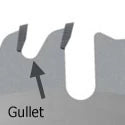 Between every tooth is the "gullet". Between every tooth is the "gullet". |
Anti-vibration & Expansion slotsLaser cut expansion slots help channel heat build-up during the cutting process, allowing the blade to expand and contract without distorting and destroying the tension of blade’s body. Anti-vibration slots absorb noise and help the blade run quiet and true by not allowing harmonic distortion to reach the cutting teeth. Filling the slots with silicone can further reduce noise. |
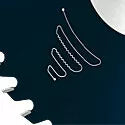 These laser-cut sections of the saw blade body reduce vibration caused by harmonic resonance These laser-cut sections of the saw blade body reduce vibration caused by harmonic resonance |
Hook AngleHook angle (or rake) is the amount of forward or backward lean of the teeth on a blade. Saw blade hook angle can range from -7° to as much as + 22°. The steeper the hook angle, the more aggressive and faster the feed rate will be. A positive hook angle (forward) will have more pull on the material than a low or negative hook blade, which is a feature best suited for ripping operations on a table saw. A low to negative hook blade is well suited for a sliding compound miter saw (SCMS) or radial arm saw (RAS) to prevent “climb” or self feeding of the material, and is especially important when cutting metals on any type of saw. Saw blades with positive hook angles will feed faster but can also increase tear out characteristics at the exit of the cut. Saw blades with a lower hook angle will have lower tear-out tendencies but will require increased feed pressure. This style of blade may have a higher tendency to burn, exposing inaccurate machine setup or technique. |
 The degree to which a saw blade tooth is angled into or away from the material at the cut The degree to which a saw blade tooth is angled into or away from the material at the cut |
Continue on to Part 3 "Saw Blade Selection"
Or go back to read Part 1 of this 3-Part Article Here
Come visit the Infinity Tools Website to see all of our great saw blades and saw blade packages.




